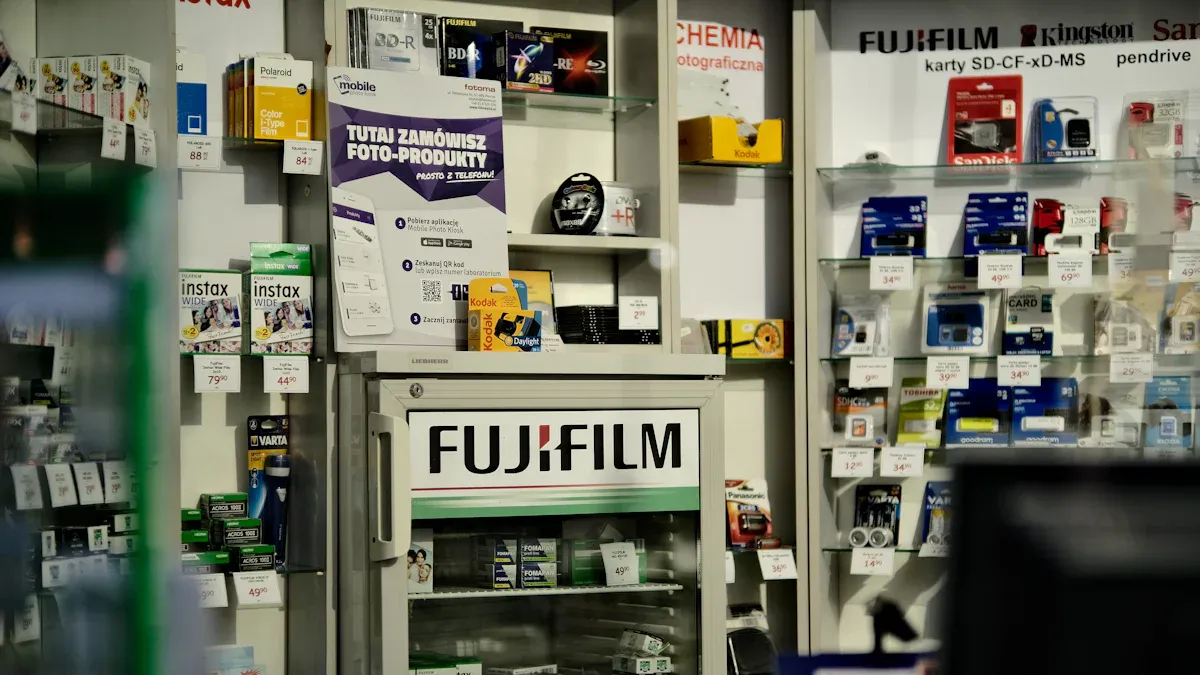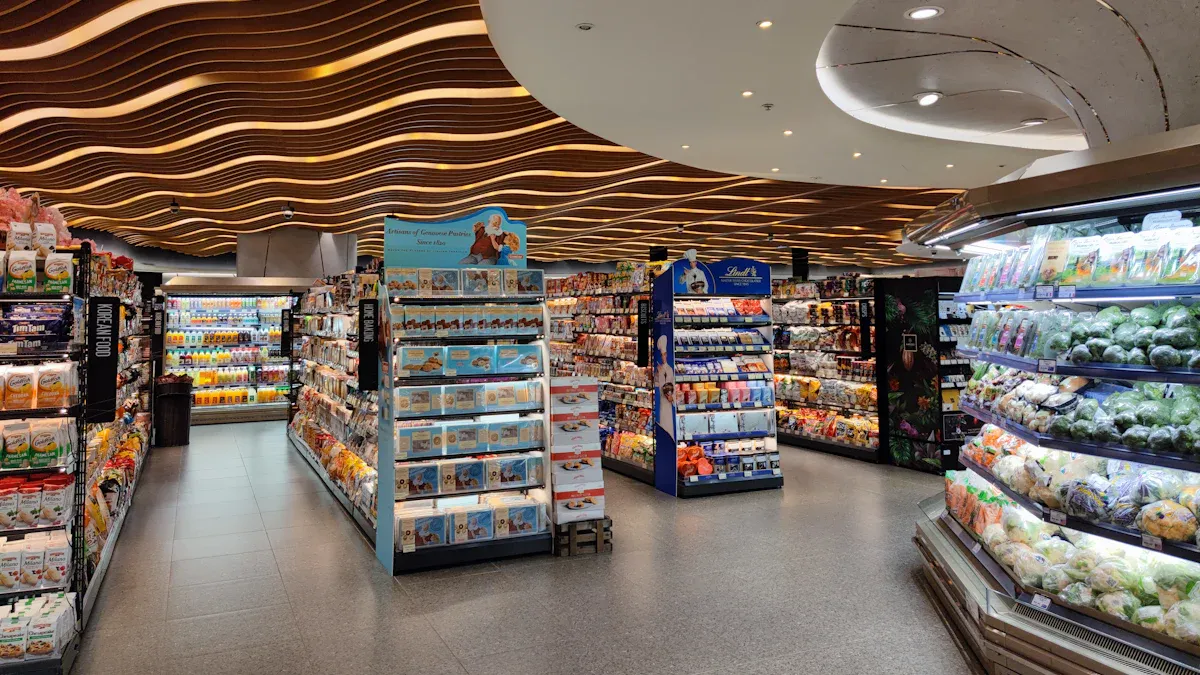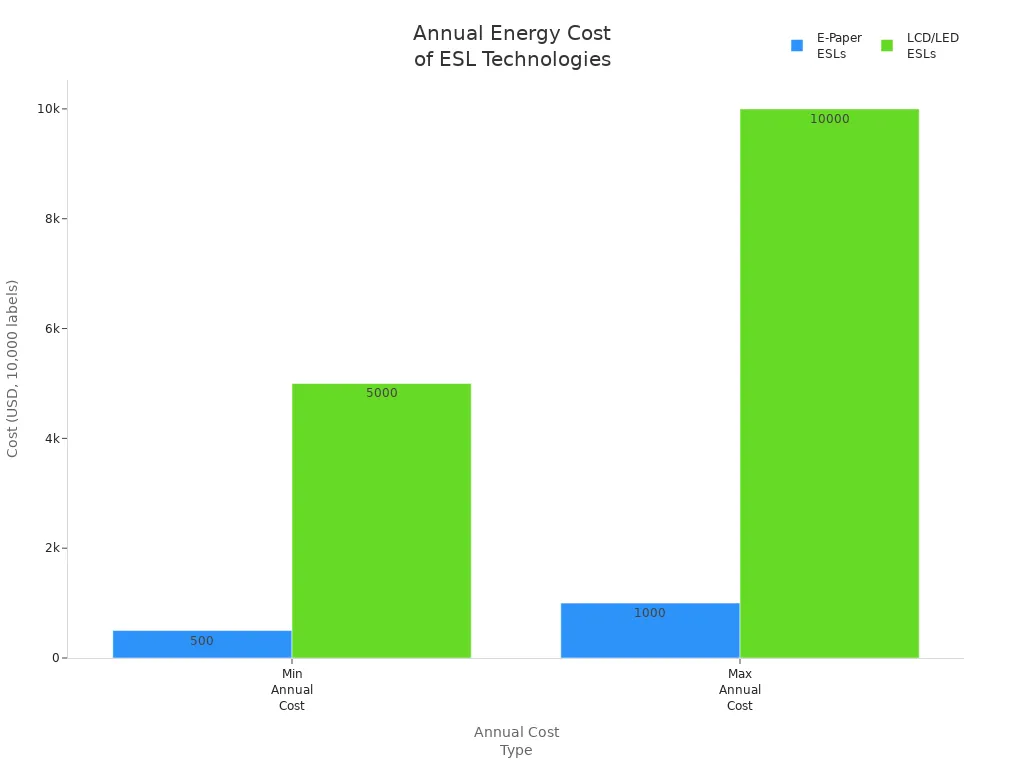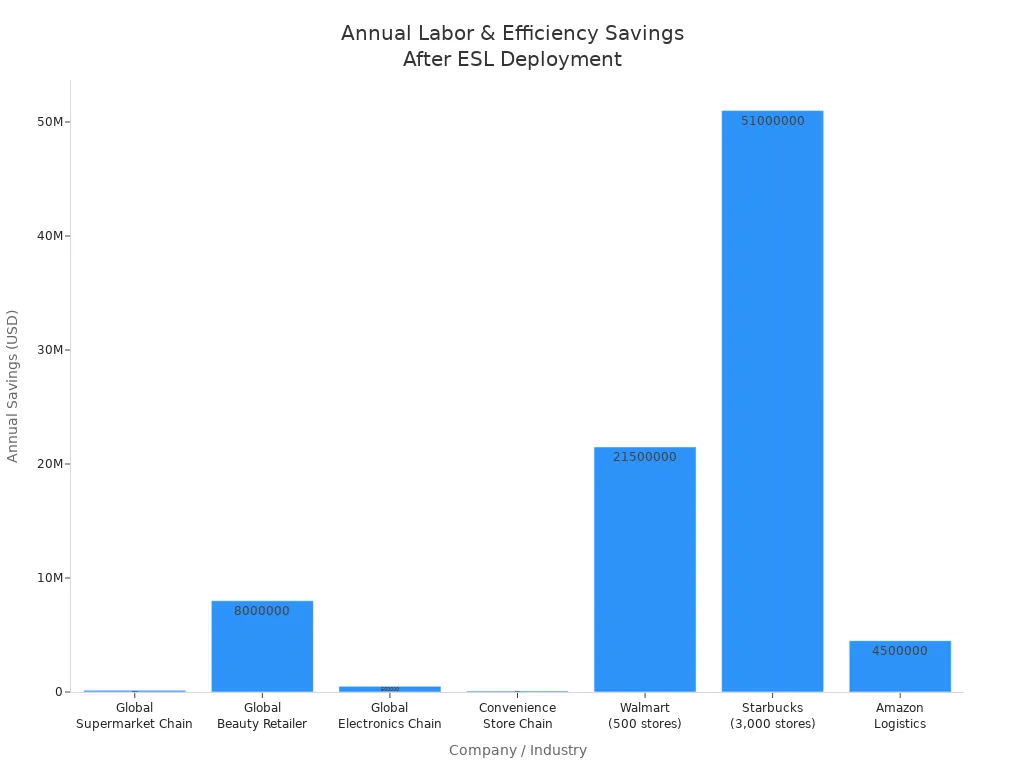
Electronic shelf labels deliver real-time pricing accuracy and drive operational efficiency. You gain faster price updates and reduce manual errors, which elevates the customer experience in every store visit. Many large retailers in Europe and Asia-Pacific already use ESL Gateway AP and ESL Price Tag systems to streamline Esl Retail operations. The table below shows global adoption trends over the past five years, highlighting the benefits and industry growth.
| Region | Adoption Details | ESL Units / Retailers Adopted |
|---|---|---|
| Europe | Over 60% of large retailers adopted ESL systems | 100+ million ESLs active |
| Asia-Pacific | 50,000+ new retail sites annually | 70,000+ retail stores adopted ESLs |
| North America | 15,000+ new outlets in five years | 2,500+ new outlets yearly |
Understanding Electronic Shelf Labels and Digital Shelf Labels

What Are Electronic Shelf Labels?
Definition and Core Features
You encounter electronic shelf labels and digital shelf labels as advanced retail technology solutions that replace traditional paper tags. These systems use electronic price tags to display pricing information and product details directly on store shelves. You benefit from features such as real-time updates, centralized management, and enhanced durability. Unlike paper tags, electronic shelf labels withstand daily wear and tear, reducing replacement frequency and operational costs.
Tip: Digital shelf labels eliminate manual label swaps, saving you time and minimizing pricing errors.
Digital Display and Wireless Technology
Digital shelf labels use e-paper, LCD, or LED displays to present clear pricing information and promotions. You see these labels communicating wirelessly through Wi-Fi, Bluetooth, NFC, or RFID. This connectivity allows you to update electronic price tags remotely, ensuring every shelf reflects accurate pricing information instantly. You also gain the ability to display QR codes, images, and multilingual content, enriching the customer experience.
- Digital shelf labels support dynamic pricing and offline updates through local storage.
- Electronic shelf labels reduce environmental impact by eliminating paper waste.
- You enjoy richer product information and interactive features, such as promotional offers and stock alerts.
How Electronic Shelf Labels Work
Integration with POS and Inventory Systems
You integrate electronic shelf labels with your point-of-sale (POS) and inventory management systems to streamline operations. The process involves several steps:
- You assess store needs, identifying issues like pricing errors or labor-intensive updates.
- You select an integration method, such as API-based for cloud POS or middleware for legacy systems.
- You install and configure digital shelf labels, ensuring stable wireless connectivity and accurate pricing information.
- You automate price updates, synchronizing changes across shelves and checkout terminals.
- You connect inventory management, tracking stock levels and triggering low-stock alerts.
- You implement dynamic pricing strategies, adjusting prices based on demand or competitor activity.
This integration ensures you maintain real-time synchronization of pricing information and inventory data, improving accuracy and efficiency.
Centralized Price and Data Management
You manage electronic price tags and digital shelf labels from a central platform. This system synchronizes pricing information, inventory, and promotions across all channels. You benefit from robust wireless networks and middleware layers that translate data between retail systems and ESL infrastructure. Centralized management enables you to update thousands of digital shelf labels simultaneously, reducing labor costs and eliminating human errors.
| Aspect | Description |
|---|---|
| Middleware Layer | Translates data between retail systems and ESLs. |
| Communication Infrastructure | Maintains stable wireless connections. |
| Data Management Systems | Synchronizes pricing information and inventory. |
| Backend Integration | Connects ESLs with ERP and e-commerce platforms. |
| Dynamic Pricing Capabilities | Enables algorithmic price adjustments. |
Types of Digital Shelf Labels
E-paper vs. LCD Options
You choose between e-paper and LCD digital shelf labels based on your store’s needs. E-paper labels offer high readability, low power consumption, and a paper-like appearance, making them ideal for supermarkets and pharmacies. LCD labels provide high-resolution images and dynamic content, suitable for electronics and fashion stores. LED shelf labels attract attention with bright displays, perfect for promotional areas.
| Type of ESL | Distinguishing Features | Ideal Use Cases | Benefits/Notes |
|---|---|---|---|
| E-Paper ESLs | High readability, low power, paper-like look | Supermarkets, pharmacies | Energy-efficient, long lifespan |
| LCD ESLs | Dynamic content, high-res images, detailed descriptions | Electronics, fashion stores | Displays images, barcodes, QR codes |
| LED ESLs | Bright, colorful, attention-grabbing | Promotions, high-visibility | Visible in any lighting, ideal for sales |
Size and Format Variations
You find digital shelf labels available in multiple sizes and formats. Large department stores use advanced models with fast update speeds, NFC capabilities, and durability. Smaller shops benefit from compact, efficient labels. Specialized labels, such as freezer models, withstand cold and moisture, ensuring reliable pricing information in challenging environments. You select the format that best fits your store layout and product range, optimizing visibility and customer engagement.
Benefits of Electronic Shelf Labels for Retailers
Enhanced Accuracy and Speed in Pricing
Real-Time Price Synchronization
You gain a significant advantage with real-time pricing when you implement electronic shelf labels. These systems allow you to update prices instantly across all your stores, eliminating the delays and manual work that come with traditional paper tags. When you synchronize digital tags with your POS system, you ensure that every shelf displays the correct pricing information. This process not only improves accuracy and consistency but also supports unified promotions and price adjustments. Maurer’s Market, for example, completed 1,400 price changes in less than 10 minutes—a task that previously took four days. You can now manage thousands of price changes in seconds, which means you spend less time on repetitive tasks and more time serving customers.
Compliance and Error Reduction
You reduce pricing errors and improve compliance by centralizing control over your pricing strategies. Automated price updates eliminate the risk of human mistakes, which often occur during manual label changes. Integration with your POS system ensures that shelf prices always match checkout prices, reducing customer complaints and regulatory risks. You also benefit from analytics and reporting tools that help you monitor pricing accuracy across all locations. This level of control supports your efforts to maintain competitive price management and meet industry standards.
Operational Efficiency and Labor Savings
Automated Price Updates
You achieve greater operational efficiency by automating price updates. In a typical supermarket, manual price changes for thousands of products can take hours each day. With electronic shelf labels, you can update all prices with a single click, saving multiple hours daily. This automation reduces labor costs by up to 80%, allowing your staff to focus on customer service and other value-added activities. A study by Pricer found that retailers saw an average reduction of 20% in in-store labor costs after adopting this technology. You also eliminate the need for printing and distributing paper tags, which further streamlines your operations.
Streamlined Shelf Management
You experience efficient resource management through streamlined shelf management. Electronic shelf labels eliminate manual tag changes and enable instant, large-scale digital updates. You can schedule price changes, promotions, and product information updates from a central platform. Features like LED-guided alerts help your staff quickly identify shelves that need replenishment, speeding up restocking and reducing out-of-stock situations. Integration with your ERP and POS systems supports real-time inventory tracking and dynamic pricing updates. You also benefit from long battery life and high-resolution displays, which reduce maintenance needs and enhance the customer experience.
Note: Cloud-based management platforms let you analyze data, schedule updates, and keep your store operations agile and responsive.
Dynamic Pricing Capabilities
Instant Market Response
You unlock dynamic pricing capabilities that let you respond to market changes within minutes. Traditional pricing methods often limit you to weekly or seasonal updates, but electronic shelf labels enable up to 100 price changes per day. Major retailers now use AI-driven pricing models to adjust prices based on demand, inventory levels, and competitor actions. For example, Walmart reduced the time needed to update 120,000 items from two days to just a few minutes. This agility supports pricing flexibility and helps you stay ahead in a competitive market.
Revenue Optimization Strategies
You optimize revenue by leveraging dynamic pricing updates and advanced pricing strategies. Electronic shelf labels allow you to adjust prices instantly for promotions, markdowns, or inventory clearance. This capability reduces waste on perishable goods and improves order fulfillment speed. The table below highlights measurable benefits that contribute to increased revenue and operational efficiency:
| Impact Area | Measurable Benefit / Metric |
|---|---|
| Automated Price Changes | Saves about 5,200 labor hours per year per store |
| Order Fulfillment | Reduces fulfillment time by 50% |
| Shelf Replenishment | Cuts time spent locating shelves by 35% |
| Waste Reduction | Decreases waste on perishables |
| Pricing Errors | Lowers human errors and customer complaints |
| Financial ROI | Pays for itself in 18 months, 277% ROI over five years |
You benefit from these efficiencies by reducing expenses and enabling more responsive, accurate pricing strategies. This approach supports both short-term sales goals and long-term profitability.
Improved Customer Experience with Digital Shelf Labels

Clear and Up-to-Date Product Information
Accurate Pricing and Promotions
You want to trust that the price you see on the shelf matches what you pay at checkout. Digital shelf labels guarantee this accuracy by connecting directly to your store’s central database. When you update prices or launch new promotions, these changes appear instantly on every shelf. This real-time synchronization eliminates confusion and reduces the risk of pricing errors. Retailers like Walmart use digital shelf labels to automate updates, ensuring customers always see the latest prices and offers. You benefit from a shopping environment where pricing is transparent and reliable, which leads to higher customer satisfaction.
Multilingual and Accessible Displays
You serve a diverse customer base. Digital shelf labels support multiple languages and accessible display options, making product information easy to understand for everyone. You can present nutritional facts, allergy warnings, and promotional details in several languages. This approach ensures that all customers, regardless of background, can make informed purchasing decisions. The technology also supports larger fonts and high-contrast displays, improving accessibility for customers with visual impairments.
Omnichannel Integration and Interactivity
QR Codes and Mobile Engagement
You can enhance your shopping journey by interacting with digital shelf labels through QR codes or NFC tags. By scanning a code, you access detailed product information, reviews, and even personalized offers on your mobile device. This feature bridges the gap between online and in-store experiences, giving you instant access to everything you need to make confident choices. Retailers use these interactive elements to provide a more engaging and informative experience, which supports improved customer experience.
Seamless Online-to-Offline Shopping
You expect a consistent experience whether you shop online or in-store. Digital shelf labels synchronize pricing, promotions, and inventory across all channels. This integration ensures that you see the same information on the shelf as you do on the retailer’s website or app. For example, you can use QR codes to add items directly to your online basket while shopping in the store. Retailers like Hy-Vee and Foto Ruano have reported smoother omnichannel operations and increased employee productivity after adopting these systems.
Note: Digital shelf labels help staff focus on customer service by automating routine updates, which further enhances your shopping experience.
Building Trust and Loyalty
Transparent and Consistent Pricing
You value transparency when it comes to pricing. Digital shelf labels provide real-time updates, so you always see the most accurate price. This transparency builds trust, especially when prices change dynamically. Clear signage and consistent information help you understand the reasons behind price changes, making you more likely to return. Retailers link these strategies with loyalty programs, encouraging repeat visits and fostering long-term relationships.
Enhanced Store Appearance
You notice the difference when shelves look organized and modern. Digital shelf labels use high-resolution graphics, dynamic colors, and even animations to create a visually appealing environment. This improved shelf appearance not only attracts your attention but also makes it easier to find products and promotions. The result is a more enjoyable and efficient shopping trip, which strengthens your loyalty to the store.
- Digital shelf labels:
- Reduce pricing errors and confusion
- Provide instant access to detailed product information
- Enhance shelf appearance with interactive features
These benefits combine to deliver an improved customer experience and support higher customer satisfaction.
Sustainability and Environmental Benefits
Reducing Paper and Waste
Eliminating Traditional Labels
You make a significant impact on the environment when you switch from paper shelf labels to electronic shelf labels (ESLs). Traditional paper tags require constant printing, replacement, and disposal, which leads to deforestation and increased landfill waste. By adopting ESLs, you eliminate the need for thousands of paper labels each week. This change helps you prevent unnecessary paper production and reduces the environmental burden of frequent label disposal.
- ESLs drastically cut down on paper waste in your store.
- You help conserve forests by reducing the demand for paper.
- ESLs use recyclable and durable components, so you replace them less often.
Lowering Carbon Footprint
You lower your store’s carbon footprint by using ESLs. These digital labels operate on long-lasting batteries, which means you dispose of fewer batteries over time. ESLs also support shelf-life management, helping you track expiry dates and reduce food waste by promoting timely sales of perishable goods. This approach not only minimizes waste but also supports a sustainable business model.
Energy Efficiency of Electronic Shelf Labels
Long Battery Life
You benefit from ESLs that use e-paper displays, which consume power only when updating information. This technology allows a single battery to last five to ten years, reducing the frequency of battery replacements and the associated electronic waste. You spend less time and money on maintenance, and you contribute to a cleaner environment.
Low Power Consumption
E-paper ESLs stand out for their ultra-low energy use. They draw almost no power when static, unlike LCD or LED labels that require constant backlighting. The table below highlights the difference in energy consumption between e-paper and LCD/LED ESLs:
| Feature | E-Paper ESLs | LCD/LED ESLs |
|---|---|---|
| Power Usage | Nearly zero when static; only during updates | Continuous power draw due to backlighting |
| Battery Life | 5 to 10 years on a single battery | Frequent replacements or wired power needed |
| Annual Energy Cost (10,000 labels) | $500 – $1,000 | $5,000 – $10,000 |
| Display Characteristics | High contrast, readable in all lighting | Bright, illuminated but higher power consumption |
| Wireless Communication | Optimized low-energy protocols (e.g., BLE) | Higher energy demands for connectivity |

You see that e-paper ESLs offer much lower operational costs and energy use, making them a smart choice for sustainable retail operations.
Supporting Corporate Sustainability Goals
Green Retail Initiatives
You align your store with green retail initiatives by adopting ESLs. Digital labels help you reduce paper waste and energy consumption, which supports your environmental, social, and governance (ESG) objectives. Many retailers now use recyclable materials and energy-efficient displays to further minimize their environmental impact. These efforts enhance your brand image and appeal to eco-conscious shoppers.
Meeting Regulatory Standards
You meet evolving regulatory standards by integrating ESLs into your operations. Some retailers have addressed the challenge of battery waste by developing ESLs powered by indoor light, eliminating disposable batteries. This innovation reduces electronic waste and supports efficient resource use. By embracing these technologies, you demonstrate your commitment to sustainability and position your business as a leader in responsible retail.
Use Cases and Practical Examples Across Retail Sectors
Grocery and Supermarkets
Real-Time Inventory and Pricing
You see rapid transformation in grocery stores when you deploy digital shelf labels. Stores in Norway and Belgium have used these systems for over a decade, updating prices up to 100 times daily. You gain the ability to match competitor prices instantly and automate markdowns for aging products. Major US retailers such as Walmart, Kroger, and Whole Foods now expand their use of electronic price tags to support dynamic pricing and real-time promotions. You benefit from reduced paper usage and streamlined operations.
- Good Food Holdings integrates digital shelf labels with Instacart’s Connected Stores program in chains like Metropolitan Market and Bristol Farms.
- Schnuck Markets uses digital shelf labels for markdowns, daypart pricing, and plans to link them with smart carts for navigation.
- Dom’s Kitchen & Market displays icons for organic, vegan, and gluten-free products, helping you make informed choices.
Tip: You can guide shoppers to products, provide recipes, and offer personalized deals directly at the shelf.
Expiry and Stock Management
You minimize food waste by leveraging digital shelf labels for expiry management. These labels enable aggressive discounts on products nearing expiration, helping you clear inventory efficiently. You monitor stock levels in real time, reducing out-of-stock situations and improving shelf replenishment. Retailers like Kroger and Hy-Vee use digital shelf labels to automate inventory tracking and support sustainability by reducing paper waste.
Electronics and Specialty Stores
Dynamic Promotions and Product Details
You create immersive shopping experiences in electronics and specialty stores with digital shelf labels. These labels allow you to update prices and product information instantly, ensuring accuracy across all channels. You display technical specifications, compatibility details, and product comparisons directly on the shelf, helping customers make informed decisions.
| ESL Feature | Benefit to Electronics and Specialty Stores |
|---|---|
| Custom Branding and Messaging | You personalize fonts, logos, and colors to align with your brand and engage customers. |
| Detailed Product Information | You provide tech specs and comparisons, reducing the need for sales assistance. |
| Dynamic Promotional Displays | You boost impulse purchases and cross-selling by showing real-time promotions and complementary products. |
Enhanced Customer Engagement
You enhance customer engagement by offering up-to-date product knowledge and interactive promotions. Digital shelf labels act as virtual salespeople, guiding shoppers and suggesting related items. You synchronize pricing and promotions with your online channels, building trust and satisfaction. This approach helps you compete with online retailers and improves operational efficiency.
Apparel and Fashion Retail
Fast Price Adjustments
You respond to market demand and competition quickly in apparel and fashion retail. Electronic shelf labels enable you to change prices in real time, giving you complete control and 100% accuracy across thousands of stores. You update prices 8 to 10 times faster than other electronic price tags, reducing manual labor and freeing staff to focus on customer service.
Seasonal and Flash Sales
You implement dynamic pricing strategies for seasonal events and flash sales with ease. Digital shelf labels allow you to adjust prices instantly, maintain accuracy, and streamline store operations. You reduce labor costs and operational inefficiencies, improving productivity and supporting rapid sales campaigns. This technology helps you stay agile in a fast-paced retail environment.
Cost, ROI, and Implementation of Electronic Shelf Labels
Investment and Ongoing Costs
Hardware and Software Expenses
When you consider electronic shelf labels for your store, you face several upfront costs. These include the price of the ESL hardware, installation fees, and software licensing or subscriptions. The total investment depends on your store size, the number of products, and the technology you select. For example, e-ink ESLs often have higher initial costs but offer longer battery life, while LCD options may require more frequent replacements. You can choose from one-time purchases, subscription-based models, or leasing options. Each approach affects your financial planning and cash flow differently.
Maintenance and Support
Ongoing costs play a key role in your total cost of ownership. You need to budget for maintenance, battery replacements, and software updates. RF-based ESLs may require battery changes every three to four years, while e-ink models can last up to ten years. Maintenance contracts and technical support ensure your system runs smoothly and minimizes downtime. By understanding these recurring expenses, you can plan for both immediate and future needs.
Calculating ROI and Value
Labor Savings and Efficiency Gains
You achieve significant labor savings when you automate price updates with ESLs. Manual price changes can take hours each day, but ESLs reduce this time to minutes. The table below highlights real-world efficiency gains:
| Industry / Company | Labor Savings & Efficiency Gains | Quantified Impact / Savings |
|---|---|---|
| Global Supermarket Chain | Reduced tag replacement time from 4 hours/day to 0.5 hours/day; employees reassigned to restocking and service. | $150,000 annual savings across 10 stores |
| Walmart (500 stores) | Annual labor, material, and error reduction savings per store. | $43,000 per store; $21.5M total annual savings |
| Starbucks (3,000 stores) | Savings in printing and labor costs; improved table turnover by syncing ESL with QR ordering. | $17,000 per store; $51M total savings; 8% increase in table turnover adds $30M revenue |

You also see fewer pricing errors and improved inventory accuracy, which further boosts your operational efficiency.
Revenue Uplift from Dynamic Pricing
ESLs enable you to implement dynamic pricing strategies. You can adjust prices instantly based on demand, inventory, or competitor activity. This flexibility helps you optimize sales and reduce waste, especially for perishable goods. Many retailers track key performance indicators such as sales lift, pricing accuracy, and customer satisfaction to measure the impact. By combining labor savings with increased sales, you maximize your return on investment and justify the initial expense.
Implementation Best Practices
Planning and Rollout Strategies
You should plan a phased rollout to manage risk and ensure a smooth transition. Start with a pilot in one section or store, then expand as you refine your processes. Work closely with your technology provider to address integration and support needs. Focus on improving operational efficiency and price accuracy to build customer trust.
Staff Training and Change Management
Prepare your team for the new system by providing thorough training. Teach staff how to use the ESL platform, troubleshoot issues, and explain the benefits to customers. Encourage feedback and adapt your approach as needed. By supporting your employees, you ensure a successful ESL implementation and long-term value.
Overcoming Common Challenges
Integration with Legacy Systems
You may encounter integration challenges when you introduce electronic shelf labels (ESLs) into your retail environment. Many stores still rely on legacy POS and inventory systems that were not designed for real-time, AI-driven pricing or wireless data synchronization. These older systems often lack compatibility with modern ESL platforms, which can create hurdles during implementation.
To address these issues, you should:
- Assess your current IT infrastructure. Identify gaps between your existing systems and the requirements of ESL technology.
- Leverage APIs and middleware. Modern ESL solutions often provide flexible integration tools that bridge the gap between old and new systems. These tools enable seamless communication and data exchange.
- Plan a phased rollout. Start with a pilot program or a single department. This approach allows you to validate the integration process and minimize operational disruptions.
- Invest in robust connectivity. Dedicated radio frequencies and multiple base stations help ensure reliable communication between ESLs and your central management system.
- Collaborate with technology partners. Many vendors offer support and expertise to help you navigate integration complexities.
Note: Migros, Switzerland’s largest retailer, successfully expanded ESL adoption nationwide by piloting the technology in select stores over several years. This gradual approach helped them overcome integration barriers and validate ROI.
Ensuring Data Security
You must prioritize data security when deploying ESLs, especially as these systems transmit sensitive pricing and inventory information wirelessly. Cybersecurity risks, such as data breaches or unauthorized access, can threaten both your business operations and customer trust.
Key strategies to ensure data security include:
- Implement strong encryption protocols. Secure all wireless communications between ESLs, gateways, and your central systems to prevent interception.
- Comply with data protection regulations. Adhere to standards such as GDPR or CCPA to safeguard customer and business data.
- Conduct regular system audits. Routine checks help you identify vulnerabilities and maintain up-to-date security measures.
- Educate your staff. Provide ongoing training on best practices for data handling and system use.
- Maintain transparency with customers. Clearly communicate your data usage policies and dynamic pricing strategies to build trust.
| Security Measure | Benefit |
|---|---|
| Encryption | Protects data during transmission |
| Regulatory Compliance | Reduces legal and reputational risks |
| Staff Training | Minimizes human error and insider threats |
| System Audits | Identifies and addresses vulnerabilities |
By addressing integration and security challenges proactively, you set your store up for a smooth ESL implementation. You gain the long-term benefits of improved efficiency, pricing accuracy, and customer confidence.
You gain measurable improvements in retail operations by adopting electronic shelf labels. The table below highlights key benefits reported by leading retailers:
| Benefit Category | Measurable Impact |
|---|---|
| Labor Cost Reduction | Up to 80% savings |
| Pricing Accuracy | Near 100% accuracy |
| Sales Performance | Up to 15% sales increase |
| Inventory Management | Real-time stock visibility |
| Price Update Speed | Changes in minutes |
| Customer Experience | Enhanced trust and satisfaction |
- You future-proof your business with dynamic pricing, real-time inventory, and seamless omnichannel integration.
- Retailers who embrace these solutions stay agile and competitive in a rapidly evolving market.
FAQ
What are the main benefits of electronic shelf labels for your store?
You gain real-time price updates, reduce manual errors, and save labor costs. ESLs improve pricing accuracy, support dynamic promotions, and enhance your store’s appearance. You also support sustainability by reducing paper waste.
How do electronic shelf labels connect to your existing systems?
You integrate ESLs with your POS and inventory systems using APIs or middleware. This connection enables centralized management and instant price synchronization across all shelves.
Can you customize the information displayed on electronic shelf labels?
You control the display content. You can show prices, promotions, product details, QR codes, and even multilingual information. Most ESL platforms offer flexible templates for different product categories.
How long do electronic shelf label batteries last?
You benefit from long battery life. E-paper ESLs typically last five to ten years on a single battery. LCD and LED options may require more frequent replacements.
Are electronic shelf labels secure?
You protect your data with encryption and secure wireless protocols. Regular system audits and staff training help you maintain security and comply with data protection regulations.
What is the typical return on investment for electronic shelf labels?
You usually see ROI within 18 to 24 months. Savings come from reduced labor, fewer pricing errors, and increased sales from dynamic pricing strategies.
Do electronic shelf labels work in cold or humid environments?
You can choose specialized ESL models designed for freezers or humid areas. These labels withstand moisture and temperature changes, ensuring reliable performance.
How do you train staff to use electronic shelf labels?
You provide hands-on training and clear instructions. Most ESL systems feature user-friendly interfaces, making it easy for your team to manage updates and troubleshoot issues.


